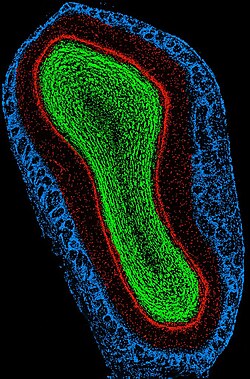Olfactory bulb
The olfactory bulb is a part of the vertebrate forebrain. It works in olfaction, or the sense of smell.
The olfactory bulb has one source of sensory input (axons from olfactory receptor neurons, and one output (mitral cell axons). It is thought that it functions as a filter. However, the olfactory bulb also gets "top-down" information from brain areas like the amygdala, neocortex, hippocampus, locus coeruleus, and substantia nigra.[1][2]
Its range of functions probably include:
- discriminating between odors
- enhancing sensitivity of odor detection
- filtering out background odors
- permitting higher brain areas involved in arousal and attention to modify the detection or discrimination of odors.
Olfactory Bulb Media
Fossil endocast of a Tyrannosaurus cranial vault, showing extensive olfactory bulb (structure to the left). Tyrannosaur dinosaurs, as well as carnivorous animals in general, have highly developed olfactory bulbs to seek out prey.
References
- ↑ Scott, J. W.; Wellis, D. P.; Riggott, M. J.; Buonviso, N. (1993). "Functional organization of the main olfactory bulb". Microscopy Research and Technique. 24 (2): 142–156. doi:10.1002/jemt.1070240206. PMID 8457726.
- ↑ Linster, Christiane; Cleland, Thomas A. (2013). "Spatiotemporal Coding in the Olfactory System". 20 Years of Computational Neuroscience. pp. 229–242. doi:10.1007/978-1-4614-1424-7_11. ISBN 978-1-4614-1423-0.


